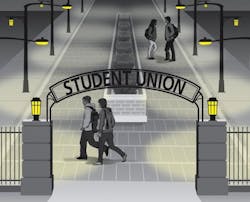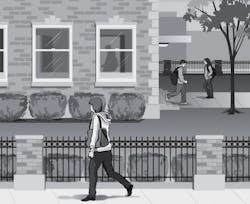BD+C exclusive: How security is influencing campus design and construction
These days, news about colleges and universities is as likely to be about the latest shooting incident on campus as it might be about academic matters. The active shooter incident at Florida State University last November was the 12th such event on a college campus in 2014.
Shootings get the headlines, but there’s a steady flow of crime on campus. In 2013, the most recent year for data collected by the U.S. Department of Education, there were 23,913 burglaries, 4,468 robberies, 4,568 aggravated assaults, 3,613 forcible sex offenses, and 6,121 motor vehicle thefts reported on college campuses, to say nothing of the 1,926 arrests for illegal weapons possessions, As of mid-December, the Justice Department was investigating sexual assault cases on 90 campuses nationwide.
Given that there are roughly 41 million students are enrolled in more than 4,000 colleges and universities in the U.S., these crime statistics pale beside the mayhem in most cities. Comparisons of crime data clearly show colleges and universities to be significantly safer than the cities and towns that surround them.
“You can’t get drawings approved without a fire marshal reviewing and signing off the plans for NFPA 101 compliance. But ask for break-resistant glazing, ground-floor protection, video surveillance, good lighting, proper landscaping design, good circulation patterns, roving patrols, or access control, and you’d think you were asking for a nuclear reactor.” — Randall I. Atlas, PhD, AIA, Vice President of Atlas Safety and Security Design
But the placid image of campus life as somehow shielded from society’s dangers isn’t what it used to be, at least in the minds of university administrators, faculty, and college students and their parents. Incidents of lawbreaking and violence still spark headlines, leading college administrators to refocus on devising ways to reduce potential threats to students, their parents, faculty, staff, and visitors.
The renewed attention administrators are giving to security is providing AEC firms with the chance to wedge a little deeper into the doorway as early-stage consultants for planning, design, and construction. AEC firms can help colleges and universities balance making campuses safer without superseding the open exchange of ideas and information that is at the core of their mission.
Firms that serve this sector—which College Planning & Management magazine estimates spends $10 billion–$11 billion annually on new buildings, additions, and renovations—can’t afford to be nonchalant about safety and security, which are now dominant factors in the design, construction, and upgrading of campuses across the country.
“Campuses are building all the time, and there are opportunities to prepare a structure for this type of threat,” says Frank Pisciotta, President of the Raleigh-based security consultancy Business Protection Specialists.
To succeed in these environments, AEC firms must find ways to navigate the choppy waters of academic bureaucracies whose constituents aren’t always tacking the same way when it comes limiting access to campuses or buildings, or spending money on ultra-sophisticated surveillance and alarm systems. The good news is that administrations are breaking down their departmental silos to develop integrated security standards.
A growing number of colleges and universities have organized security committees to make those decisions. Public safety and IT personnel on these committees are having a greater influence than ever before on what gets built or installed, where, and for how much. “Everything we build has a security component,” says Frank Demes, Interim Chief, Office of Safety and Security at George Washington University in the nation’s capital.
Jeff W. Fields, PSP, CHS-III, an Atlanta-based security consultant, says that universities are more likely these days to take seriously the advice of security experts when it comes to evaluating the strengths and weaknesses of their campuses’ public safety programs. That’s a far cry from what he calls “the bad old days” of the mid-1990s, when Fields couldn’t convince one client—a college with railroad tracks running 50 feet from its residence halls—to improve its perimeter lighting and alter its pedestrian traffic patterns.
When it comes to public safety on campuses, however, it appears that AEC firms are more the rhythm section than the lead guitar. They’re usually not sitting on those security committees—and Fields wonders if these firms would add much to the deliberations.
Even when it can be demonstrated that good design can enhance campus safety, some administrators balk at the expense, says architect Randall I. Atlas, PhD, AIA, Vice President of Atlas Safety and Security Design. “You can’t get drawings approved without a fire marshal reviewing and signing off the plans for NFPA 101 compliance,” says Atlas, a Certified Protection Professional with the American Society of Industrial Security. “But ask for break-resistant glazing, ground-floor protection, video surveillance, good lighting, proper landscaping design, good circulation patterns, roving patrols, or access control, and you’d think you were asking for a nuclear reactor.”
Atlas’s frustrations notwithstanding, administrative intransigence has been waning, partly because campus crime statistics are glaringly available for students and their parents to scan. Plenty of colleges and universities have moved safety and security to their front burners and are looking to experienced AEC firms for guidance.
Take New York University, which Security magazine ranks second among the nation’s securest campuses. Nestled in New York’s Greenwich Village, NYU owns or leases 110 buildings and 11 million sf of space. Alexis Roberts, NYU’s Senior Director of Site Strategies for Public Safety, told BD+C recently that the university was in the process of forming a security committee. Partnerships with AEC firms are a “major component” of campus crime prevention, says Andrew Repoli, Director of NYU’s Office of Construction Management. “They are at the table to ensure they understand what we require, and that it gets into the drawings.” While NYU’s public safety department has the final say, “there absolutely has to be a dialogue,” he says.
The University of Pennsylvania, ranked the safest institution in the nation by Security, has 600 architects in its database. David Hollenberg, AIA, Architect for Penn’s Facilities and Real Estate Services, says he meets with outside architects two to three times a month, but RFPs “are by invitation only.” What Penn looks for in its AEC partners, says Hollenberg, is their capability, record of design excellence, team intellect, and—perhaps most important—their familiarity with the university campus and the city of Philadelphia.
Penn has developed a 150-page engineering guidebook that Hollenberg says is “integral” to the planning process. But the university prefers to give the architecture firms it works with the latitude to pick their engineers and other team members. “There are no arranged marriages here,” he says.
Security consultant Pisciotta says AEC firms’ involvement in campus safety typically starts with assessing a project’s risk. Firms with professionals on staff who have qualified security credentials have a leg up. Pisciotta thinks AEC firms also could be playing larger roles in developing design and construction standards, especially in the area of design to manage a wide variety of facilities—residence halls, classrooms, dining halls, etc.—for safety and protection.
David Keith, AIA, LEED AP, Design Director and Principal with Clark Nexsen, says his architecture/engineering firm is most useful to those institutions that seek its counsel about master planning and site design, where safety issues such as pedestrian traffic flow and access control into and around buildings are first discussed.
Keith thinks early involvement would prevent blind spots or hiding places from creeping into a design that could potentially impede, or at least complicate, the safety and security of a building. Early involvement might also help change administrators’ “bunker” mentality that architects and safety experts say still serves as some colleges’ default safety strategy.
That sentiment is echoed by Joseph Collins, FAIA, NCARB, LEED AP, a Partner with ZGF Architects. “All too often, buildings on campus are thought of as islands in a stream,” he says. “The trick is to approach site infrastructure, landscape, and design as an integrated process.”
THE FIRST LINE OF DEFENSE: CHECK OUT WHO’S COMING IN
While different types of buildings require different levels of security, the design and construction of any campus structure are going to include security features that, in many cases, are determined by crime data and driven by technology.
Here’s a closer look at what colleges and universities have been asking their AEC partners to incorporate into new, renovated, and existing structures on campus:
Rigorous access control. Every expert interviewed for this article pointed to access control as the single most effective way to deter campus crime. The University of Pennsylvania is currently building a $127 million college house—i.e., residence hall—that will have 350 beds and only one entrance. (Bohlin Cywinski Jackson is the architect; INTECH Construction, the construction manager.) Having that single entryway, says Hollenberg, “drove the design and was at the core of the planning.”
When security consultant Fields heard about the active shooter who tried to penetrate a library on Florida State University’s campus in late November, he says the first thing he thought was “Did the shooter get into the building, and was there controlled access?” Fields is convinced that altering traffic patterns to control and monitor access into buildings is considerably more effective security than installing bulletproof glass or sturdier door locks.
James Clark, Managing Partner, Clark Security Group, is a proponent of using lighting and physical structures to redirect pedestrian or vehicular traffic entering college campuses onto streets that are either patrolled or monitored by cameras. He notes that Disney and IKEA control crowds this way “and no one seems to mind.” Clark says that the quadrangular layout of many structures built on campuses in the 1960s and 1970s actually make access control easier to manage.
However, colleges and universities are different from K-12 schools or office buildings in two distinct ways: first, as institutions of learning, they actively invite visitors to their campuses for interaction and dialogue; second, their campuses are often central to the social fabric of their local towns and cities. Consequently, faculty, administrators, and students often push back against design and construction practices that stifle the free exchange of ideas, or that create—or even seem to create—a wall between the institution and the community.
Urban colleges have the added burden of ambiguous boundaries that make unobtrusive security all the more difficult to execute. NYU—which has more than 11,000 access levels, depending on the building or room, says Roberts—will soon start retrofitting a 500,000-sf property in downtown Brooklyn, N.Y., into an academic center for its engineering and applied sciences programs.
The building, which was once headquarters for the Metropolitan Transportation Authority, has several subway lines running into it, so masses of subway riders and students will be flooding the area every day. The retrofit—from a design by Mitchell|Giurgola Architects—will also convert 14,000 sf to retail space. In addition to having a public safety officer posted at the entrance, students, faculty, and staff will have to use their ID cards to get through the security turnstile. In sensitive areas like laboratories, they will have to pass through an additional layer of security beyond the usual card swipe, says Roberts.
“All too often, buildings on campus are thought of as islands in a stream. The trick is to approach site infrastructure, landscape, and design as an integrated process.” — Joseph Collins, FAIA, NCARB, LEED AP, Partner with ZGF Architects
W.M. Jordan Company is building a new residence hall on the campus of Virginia Commonwealth University, in Richmond. The 399-bedroom complex, designed by Clark Nexsen, will have a common open space and an alleyway accessible to the public. First-floor retail and conference/meeting spaces will be available along one street. After considering several security options, says Keith, the design firm and the university came up with a compromise that will require students to use a card key to get through a gated area monitored by cameras. The residence halls will have only one entrance, with a manned security desk.
Crime Prevention Through Environmental Design. CPTED has been around for decades as one of the more elegant ways to keep unwanteds from entering certain areas on campus. “Sometimes it’s your only defense,” says Chad Parris, President of Security Risk Management Consultants. That’s especially true for urban campuses that have public streets running through them. The boundaries between town and gown can be “very porous,” says Parris.
John Kleberg, a Consultant with Parris’s company, describes CPTED as “design that incorporates interior and exterior security with territorial reinforcements that define the space.” CPTED can take many forms, he says. It could be a well-manicured hedge that restricts or directs access. It could be uplighting a structure to make it harder for intruders to hide, while accenting the building’s aesthetic features. It could be something as simple as a reception desk, says Kleberg, because a desk creates a manmade barrier.
Kleberg says that for campus landscaping to be most effective, it must not only be attractive, it must also regulate pedestrian traffic flow: “You don’t want the campus to be like a bank; you want it to be open.” He advises landscape architects and contractors to hold off laying sidewalks until they can see if students are taking routes that could put them in danger; if so, permanent sidewalks should be laid out along safer paths.
There’s consensus among experts we consulted that older buildings are harder and more expensive to trick out for security, especially when they’ve been added onto over the years. ZGF’s Collins believes “the easiest fix” is to illuminate older buildings, rather than trying to redesign them. He says lighting should be an essential ingredient in making any place—from the residence hall lobby to a parking garage—safer for users. The advent of much more affordable, energy-efficient LED lighting has made objections to this solution for cost reasons less defensible, he contends.
Surveillance and alarm systems. For parking garages, public safety experts and architects say lighting works best when used in tandem with white or reflective paint on the ceiling of each deck. However, most colleges and universities beef up their garage security with emergency call boxes, alarms, and surveillance cameras.
Security-related technology is pervasive on American campuses, and IT personnel appear to be assuming a much greater role in decision making about campus safety. That can be a double-edged sword, says Atlas, who questions how much IT people actually know about security.
On the positive side, IT’s higher profile in campus safety is pushing colleges to establish security equipment standards, which are important when replacing legacy systems. IT’s greater involvement is also helping to reel in the practice of decentralized procurement, which has left many campuses with a conglomeration of systems that can’t talk to one another.
The University of Pennsylvania has addressed the procurement problem by mandating that any new technology must be able to integrate with Tyco International’s Software House security management system, according to Maureen Rush, Penn’s Vice President for Public Safety.
After operating on multiple systems for decades, Ohio State University finally came up with a unified security platform, which Parris says took OSU—one of his clients—five years to develop. Only in the last two years has OSU’s medical center, which is autonomous from the university, attempted to integrate its security systems with the main Columbus campus.
WATCHING AND WAITING: CAMERAS ON CAMPUS
Surveillance cameras don’t prevent crime. Nevertheless, camera surveillance is alive and well on America’s campuses. Many large universities have thousands of cameras at work. The University of Pennsylvania’s Public Safety division has access to 2,000 stationary cameras and 130 pan-tilt-zoom models.
Higher education’s reliance on cameras as a psychological deterrent and a forensic starting point for investigations is growing. “When technology is present and working, word spreads,” says Security Risk Management’s Parris.
New York University has been analyzing video to develop the appropriate alarm integration with its motion-activated cameras, says Roberts. Penn is experimenting with cameras that emit beams that, once broken, set off an audio alarm and take a picture of persons on the scene. The university is beta testing these systems at bike rack installations, says Rush.
Another technique is the use of “repeaters” that minimize WiFi or radio-frequency dead spots that block or impede the transmission of alarms or alerts. ZGF’s Collins says his firm uses repeaters whenever the design of a collegiate building calls for the installation of communications systems.
The pervasiveness of camera surveillance on campuses is also having an impact on building design. Some institutions—New York University is one, according to Repoli—are asking for straighter corridors, more interior visibility, and clearer exterior site lines to enhance visual surveillance.
EVERYONE NEEDS TO MAKE CAMPUS SECURITY A PRIORITY
Taken together, these security measures would appear to be making colleges and universities safer. But any public safety program, no matter how rigorous or sophisticated, has limits.
Security consultant James Clark says that schools could be making better use of their campus security personnel. He says colleges and universities need to encourage students, faculty, and staff to report any unusual events to campus security, so that the burden of detecting potential crimes doesn’t fall entirely on the university police force.
Architectural design and construction can play an important role in university security. Atlas says it’s worth noting that the shooter at FSU was thwarted from getting into the library by something as simple as a turnstile and security desk at the entryway. “In that case, prevention turned out to be the cure,” he says.
But it’s still not clear how many colleges and universities will look to AEC firms as full partners in devising their public safety strategies, rather than simply viewing them as executors of building programs divined internally. AEC firms’ best course might be to stay true to their principles and do their best to mesh those ideals with the institution’s security priorities.
The editors wish to thank the following experts for their help with this article:
Randall I. Atlas, Ph.D, AIA, CPP, Vice President
Atlas Safety & Design
Fort Lauderdale, Fla.
James Clark, CPP, Managing Partner
Clark Security Group
Avon Lake, Ohio
Joe Collins, FAIA, NCARB, LEED AP BD+C, Partner
ZGF Architects
Portland, Ore.
Michael J. Dausch, PE, Executive Director
Facilities & Construction Management
University of Pennsylvania
Philadelphia, Pa.
Frank Demes, CCAS, Interim Chief of Police
George Washington University
Washington, D.C.
Jeff W. Fields, PSP, CHS-III
Physical Security Consultant
Atlanta, Ga.
David Hollenberg, AIA, Executive Director
Facilities and Real Estate Services
Design & Construction Management
University of Pennsylvania
Philadelphia, Pa.
David Keith, AIA, LEED AP BD+C, Design Director, Principal
Clark Nexsen
Virginia Beach, Va.
John Kleberg, Consultant
Security Risk Management Consultants
Columbus, Ohio.
Fred Miehl, CPP, Senior Security Consultant
LynStaar Engineering
Pleasantville, N.Y.
Chad Parris, CSC, President
Security Risk Management Consultants
Columbus, Ohio
Frank Pisciotta, CSC, President
Business Protection Specialists
Raleigh-Durham, N.C.
Andrew Repoli, R.A., Director, Global Facilities and Construction Management, Division of Operations
New York University
New York, N.Y.
Alexis Roberts, Senior Director–Site Strategies
Public Safety, Division of Operations
New York University
New York, N.Y.
Maureen S. Rush, CPP, Vice President for Public Safety
Superintendent of Penn Police
University of Pennsylvania
Philadelphia, Pa.
Brian Van Brunt, President
National Behavorial Intervention Team Association
SVP, The NCHERM Group
Malvern, Pa.





